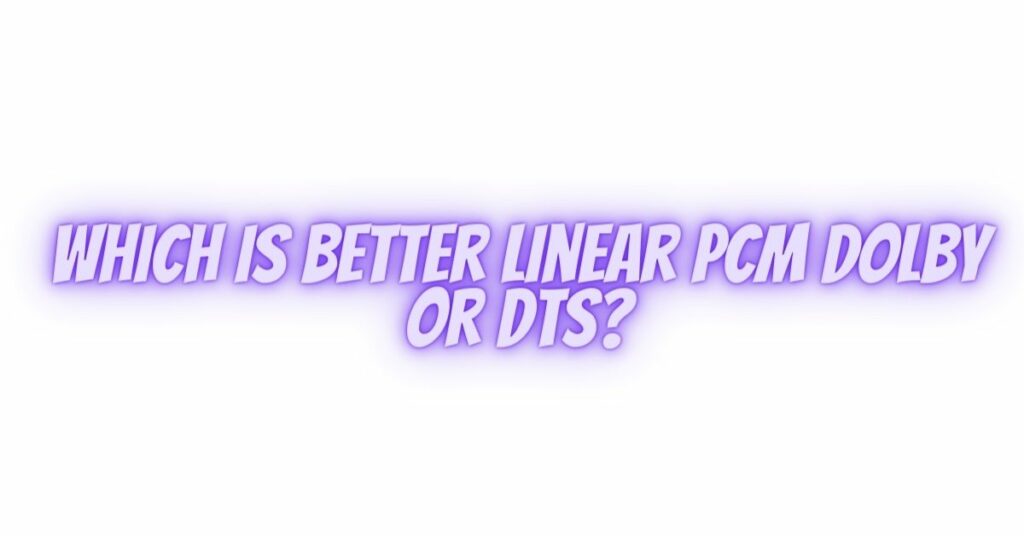The world of audio formats can be a complex and technical realm, and understanding the differences between various formats is crucial for a high-quality listening experience. Linear PCM, Dolby, and DTS are three common audio formats used in home theaters, cinemas, and digital media. In this comprehensive article, we will explore these formats, compare their features, and help you determine which is better for your specific audio needs.
- Linear PCM (Pulse Code Modulation):
Linear Pulse Code Modulation, or LPCM, is a digital audio format that represents audio as a series of discrete values. It is considered a lossless audio format, which means it captures audio signals without any compression or data loss. LPCM is the same format used in CDs and is widely regarded for its high audio quality.
Advantages of Linear PCM:
- Uncompressed Audio: LPCM preserves audio in its original, uncompressed state, resulting in the highest possible audio quality. It’s often considered the gold standard for audio fidelity.
- Wide Compatibility: LPCM is a universal format that is compatible with nearly all audio and video playback devices, making it a versatile choice.
- Dynamic Range: LPCM supports a wide dynamic range, ensuring that both soft and loud sounds are faithfully reproduced.
- Multi-Channel Audio: LPCM can accommodate multiple channels, making it suitable for surround sound formats.
- Dolby Digital:
Dolby Digital, often referred to as AC-3, is a widely used audio compression format. It is known for its presence in DVDs, Blu-rays, and streaming content. Dolby Digital employs lossy compression, which means it reduces file sizes by discarding some audio data, but it does so intelligently to maintain high audio quality.
Advantages of Dolby Digital:
- Efficient Compression: Dolby Digital provides a good compromise between audio quality and file size, making it practical for various media.
- Support for Surround Sound: It supports up to 5.1 channels of audio, making it ideal for surround sound applications.
- Widespread Usage: Dolby Digital is a common format in the entertainment industry, ensuring broad compatibility with both hardware and software.
- DTS (Digital Theater Systems):
DTS is another lossy audio compression format that competes with Dolby Digital. It is often found on DVDs, Blu-rays, and some streaming services. DTS is renowned for its high-quality sound and its support for higher bitrates, which can result in even better audio fidelity compared to Dolby Digital.
Advantages of DTS:
- High Bitrates: DTS formats often support higher bitrates than Dolby Digital, allowing for potentially superior audio quality.
- Lossy Compression with Quality: DTS achieves compression without significant loss in audio quality, making it a preferred choice for audiophiles.
- Compatible Hardware: DTS is compatible with a wide range of home theater equipment and sound systems.
Choosing the Best Audio Format:
Selecting the best audio format among LPCM, Dolby Digital, and DTS depends on several factors:
- Media Source: Consider the source of your content. If you’re watching a DVD or Blu-ray, it likely contains either Dolby Digital or DTS tracks. Streaming services often use Dolby Digital or its variants, while LPCM is more common in music and some high-end video sources.
- Audio System: The capabilities of your audio system matter. If you have a high-end audio setup, LPCM or DTS may provide a more immersive experience due to their higher bitrates. However, for standard setups, Dolby Digital is sufficient.
- Content Type: The type of content you’re enjoying matters. For movies and cinematic experiences, Dolby Digital or DTS are excellent choices due to their support for surround sound. For music, especially in lossless formats, LPCM is often preferred.
- Personal Preference: Ultimately, personal preference plays a significant role. Some listeners may be more discerning about audio quality, while others may not notice the difference. It’s essential to choose the format that provides the best experience for your ears and your setup.
Conclusion
The question of whether Linear PCM, Dolby Digital, or DTS is better is subjective and depends on various factors. Each format has its own advantages and best applications. The best choice for you depends on your media source, audio system, content type, and personal preferences. Understanding the characteristics of each format empowers you to make informed decisions that result in an optimal listening experience for your specific needs.


